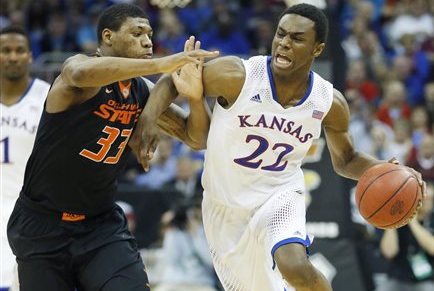Andrew Wiggins NBA Draft 2014: Highlights, Scouting Report for Cavaliers Rookie
June 15, 2014
Drafted by: Cleveland Cavaliers, No. 1 pick overall
School: Kansas
Height/Weight: 6'8", 200 lbs
Age: 19 years old
Projected NBA Position: Small Forward
Pro Comparison: Paul George/DeMar DeRozan
Twitter Handle: @22Wiggins
No player entered the 2013-14 college season with higher expectations than Andrew Wiggins, who was dubbed by many as the top prospect since Kevin Durant.
And though he didn't steal the show, Wiggins finished as the most productive player on a premier team in arguably the toughest conference in America, the Big 12. Wiggins certainly flashed the upside that was tied to his outlook coming in. But he'll have some important questions to answer and improvements to make before reaching the awfully high bar that's been set for him.
| Statistics at Kansas | |||||
| PTS | REB | AST | STL | FG% | 3P% |
| 17.1 | 5.9 | 1.5 | 1.2 | .448 | .341 |
| NCAA.com | |||||
PHYSICAL TOOLS
Wiggins was blessed with textbook tools for the NBA small forward position. At 6'8" with a 7'0" wingspan, he has ideal measurements to match his elite-level athleticism. Wiggins' lightning-quick first step makes him nearly impossible to contain in space, while his ability to elevate higher than anyone allows him to separate for shots from all over the floor.
He'll immediately step in as one of the top athletes and most explosive leapers in the NBA. Take away his offensive skills, and Wiggins could still score in double digits based on his ability to pick up easy buckets above the rim.
CORE STRENGTHS
Attacking, Slashing
Wiggins is at his best attacking the rim, whether it's off the dribble or off the catch. He can explode through gaps and above traffic around the basket. He took 227 free throws as a freshman. Between his first step and slippery spin move, Wiggins is tough to keep from getting off a clean look once he's blown past the perimeter defense.
Off the ball, he's an electric slasher and cutter through traffic, and he's a constant threat to slip behind the defense for a backdoor lob.
Mid-Range, Perimeter Scoring Potential
Wiggins didn't score 17.1 points a game just off layups and dunks. His perimeter scoring arsenal came around by the end of the year. Wiggins began hitting defenders with pull-up and step-back jumpers, and though his consistency suffered, he proved he has the game to generate offense away from the rim.

He actually looked like a much better shooter (56.3 true shooting percentage, per Sports-Reference.com) than he was given credit for entering the season.
From long range, Wiggins made 43 three-pointers at a 34.1 percent clip. His delivery and stroke are concise, though he still needs to get better at making contested shots. And moving to a deeper three-point arc will likely call for a significant adjustment.
In between, his signature floater should be a weapon in the NBA against bigger, longer rim protectors.
Defense
Wiggins has special defensive potential, given his size, length and foot speed. He might be able to lock down 1s, 2s and 3s.
When he's locked in, Wiggins has the ability to deny his man the ball. He's disruptive. Wiggins' 1.2 steals per game isn't a great reflection of just how effective he can be.
The fact that he's a defensive asset is a big selling point, considering many of the top 2014 prospects only excel on one side of the ball.
WEAKNESSES, CONCERNS
Fundamentally, Wiggins still has to refine and polish up his skills. He's a capable shooter, but not a consistent one. He has to improve his handle in traffic, specifically his left hand. He also has to become a more focused passer. And he struggled this season with finishing challenged shots at the rim. At 200 pounds, he lets length and contact bother his shot.
But the biggest concern with Wiggins stems from his lack of visible killer instinct. He's vulnerable to disappearing for stretches and disengaging from the game. Wiggins finished with just four points on six shot attempts in 34 minutes with Joel Embiid out of the lineup in a loss to Stanford in the NCAA tournament's round of 32.
Will Wiggins become the guy you can go to for a bucket with your team down one in the fourth quarter? That's the question executives have been grappling with during the season and evaluation process.
NBA PROJECTION
Immediate Projection
Wiggins should be able to step in right away and convert some easy buckets in the drive-and-slash game as well as on the break. He'll also provide an immediate defensive boost, given his versatility and lockdown tools.
He won't be the favorite to win Rookie of the Year, as he's just not polished enough to put up consistent offensive results in the half court. But he'll have the chance to start from day one and log regular minutes throughout. Wiggins will get his points, but his impact might fluctuate.
Long-Term Projection
Wiggins has the highest upside in the draft outside of Embiid. The All-Star talent is there. Whether he'll be able to tap into it and ultimately assert himself on a game-to-game basis will determine just how far he'll go.
He's going to be a phenomenal player when it's all said and done. The fact that he averaged 17.1 points as a freshman without much refined skill is extraordinary. Still, Wiggins might ultimately be more effective as a Scottie Pippen-like No. 2 option than a Michael Jordan-like No. 1.